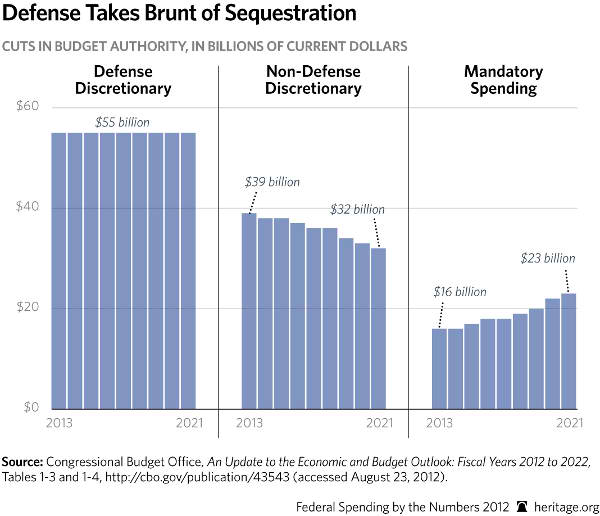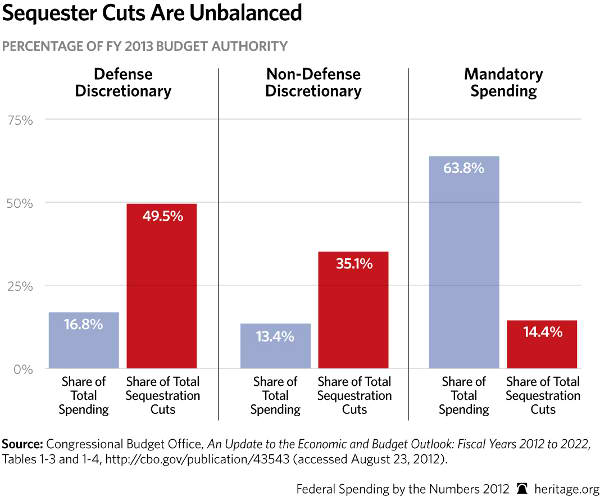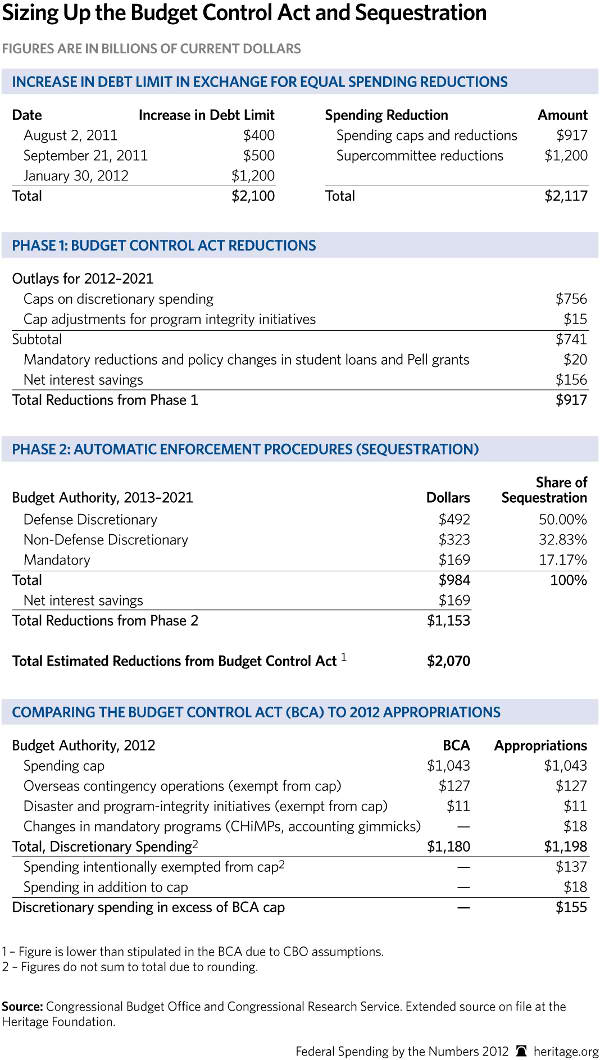Abstract: The Budget Control Act created an automatic enforcement regime that would cut federal spending by $1.2 trillion, including a devastating $55 billion per year reduction in national defense. Having failed to act all year, Congress now faces the first thrust of this “sequestration,” scheduled to start January 2. To avoid slashing defense, Congress should draw from proposals to replace these sequestration cuts. This report offers proposals that could achieve $150 billion in annualized savings.
With the 2012 election now passed, Congress can no longer evade responsibility for the steep and reckless spending cuts scheduled to decimate the national defense budget starting January 2. Instead of letting this crude mechanism substitute for Congress as a governing institution, lawmakers should do what they should have done months ago: replace these mindless across-the-board cuts with specific, targeted terminations and reductions.
Lawmakers may wring their hands over the “extraordinarily painful” choices needed to offset the $55 billion in 2013 defense cuts, but a sampling of non-defense options presented at the end of this paper shows $150 billion in potential annual savings. Many of the proposed reforms and reductions are long overdue; others were developed in the House reconciliation bill that aimed at replacing the sequester. The point is: Savings are available if Congress has the will to act.
Members of the 112th Congress accepted this automatic enforcement regime, proposed by the Obama Administration (the President’s denials notwithstanding),[1] thereby manufacturing the problem. The President has claimed sequestration will not happen[2] but has offered no solution. Therefore, the task falls to sitting lawmakers. They should stick to what is necessary—replacing the sequester—not encumber the legislation with “grand bargains,” tax increase compromises, or specialized ad hoc procedures promising broader deficit reduction later on. Their aim should be to stabilize the situation for at least long enough to allow the new Congress to develop a longer-term solution.
What Is Sequestration?
Sequestration is a product of last year’s lengthy debt ceiling debate. At the end of that process, in August, Congress passed the curiously named Budget Control Act (BCA)—which merely created another process to substitute for real budgeting. The legislation in part created a 12-member “supercommittee” to come up with $1.5 trillion in deficit reduction over 10 years. If the committee failed or if Congress and the President refused to enact its recommendations, an automatic enforcement regime would kick in on January 2, 2013, indiscriminately slashing $1.2 trillion in spending through 2021. When supercommittee members failed to agree on a deficit reduction package, they set the sequestration clock in motion.
Reflecting its extraordinarily unbalanced character, the procedure draws $492 billion of its savings—about 10 percent per year—from national defense. It does so even though defense, a core constitutional function of the federal government, represents less than 17 percent of total spending. Meanwhile, more than two-thirds of entitlement spending—which consumes more than 60 percent of total outlays—is shielded from the cuts. Social Security and Medicaid are fully exempt, as is all but 2 percent of Medicare spending. Another 18 percent of the cuts is to come from reduced interest payments.
Defenders of the BCA argue that this automatic enforcement mechanism was never intended to take place. It was designed to be so onerous as to bring Congress to its senses—making rational budget reduction proposals—before sequestration occurred.
Yet only one chamber of Congress responded. In May, the House passed a budget “reconciliation” bill aimed at replacing the first year of sequestration cuts with alternative savings, including in entitlement programs. The measure was far from perfect: Its first-year savings of about $15 billion offset less than one-fifth of the $78.5 billion in sequestration reductions it would replace, and its $328 billion in net savings would trim just slightly more than 1 percent from federal entitlement spending over the next 10 years.
Still, the House proposal was infinitely better than the Senate’s answer to the looming sequestration—which was precisely nothing. The threat of deep, automatic spending cuts failed to induce the Senate majority to act responsibly; hence, the Damocles’ Sword of sequestration now hangs over the entire Congress ever more precariously.
In many respects, the damage already has been done. Defense contractors, for example, have been paralyzed for months, uncertain of how the Pentagon budget—and hence their own production lines—would be affected. With Congress and the President also having failed to enact a single annual spending measure for fiscal year (FY) 2013, the entire government is operating on a temporary, six-month continuing resolution that could itself be slashed by sequestration starting in January.

Replacing Sequestration
To replace sequestration, it is helpful to understand how the mechanism is applied. For the first year, FY 2013, sequestration works by cancelling budgetary resources already in place in certain discretionary and mandatory programs. This is similar to a rescission bill, in which Congress cancels budget authority for a fiscal year already under way. Spending cuts intended to replace the sequester would function similarly.
For FY 2014–FY 2021, the discretionary spending reductions are achieved by lowering the caps on annually appropriated spending for those years. That will still require Congress either to identify policies to achieve those savings or to allow across-the-board reductions to occur.

Guidelines for Spending Cuts
The Heritage Foundation’s long-term budget plan, Saving the American Dream[3] spells out a set of principles for guiding spending reductions to reduce the size and scope of government. These criteria are useful in choosing policies for replacing sequestration as well.
- Federalism. The federal government should focus on a limited number of appropriate governmental duties suited to its national role, leaving states and local governments—which are closer to the people—to address areas such as transportation, education, job training, economic development, and others. For too long, Washington has seized increasing shares of these activities, smothering the creativity of state and local officials.
- Privatization. Similarly, the federal government has assumed myriad activities that are beyond the necessary role of government at any level. These should be restored to the private sector. The government-operated Amtrak is a good example of how not to run a railroad: It lost $84.5 million on its food and drink services in 2011 and $833.8 million over the past 10 years. Privatizing food service would be a first step toward privatizing the entire railroad.
- Consolidation. Overlapping and duplicative programs are rampant throughout the federal government. Washington could save taxpayers substantial sums by consolidating programs or simply eliminating those that overlap or duplicate one another. One of the most celebrated examples is job training. The government spends about $15 billion annually on about four dozen job-training programs spread across nine agencies. Consolidation could save several billion dollars a year. There are more than 100 economic development programs spread across five agencies in the Department of Transportation and 82 teacher quality programs in the Departments of Defense, Education, and Energy, as well as NASA and the National Science Foundation.[4 ]
- Targeting. The allocation of federal funds is always influenced by political considerations, resulting in more spending than necessary. Targeting resources to where they are really needed would save billions. Community Development Block Grants, for instance, receive more than $3 billion a year, much of which goes to well-off communities that do not need the extra cash.
- Eliminating ineffective programs. The federal government is rife with programs that are no longer, or never have been, effective. Most survive solely because of entrenched constituencies or undue popularity. Increasing evidence shows, for example, that the $8 billion Head Start program is ineffective and should be reduced—or, better still, eliminated.[5 ]
- Clearing out waste, fraud, and abuse. Examples of wasteful government spending are all but limitless. They range from $115 billion in improper payments in programs such as Medicare, Medicaid, and the earned income tax credit to $1.7 billion to maintain 77,700 unused or underused buildings.[6 ]
The appendix to this paper identifies more than $150 billion of potential spending reductions—a broad menu from which Congress should be able to find $55 billion in savings. Making such choices would alleviate the immediate pressure of sequestration. It also could provide a worthwhile first installment on the long-term reductions needed to get federal spending under control.
Finish the Unfinished Business
Congress has known since last November that sequestration was scheduled to fall. Lawmakers had all of 2012 to replace these broadsword reductions with real spending cuts achieved by setting priorities and making choices. They chose not to act. Now they must scramble to finish this unfinished business or let the broadsword fall.
The President and Congress created this crisis. They are capable of resolving it—if they choose to act.
—Patrick Louis Knudsen is the Grover M. Hermann Fellow in Federal Budgetary Affairs in the Thomas A. Roe Institute for Economic Policy Studies at The Heritage Foundation.
Appendix
Potential Sequestration Replacement Proposals
| Estimated Annualized Savings (in millions of dollars) | Proposal |
| Agriculture | |
| $4,500 | Phase out or cap farm subsidies. |
| $400 | Reduce premium subsidy in crop insurance. |
| $5,638 | Restrict automatic eligibility for food stamps, accelerate sunset of enhanced stimulus food stamp benefits, and adjust terms for food stamp heating and cooling allowances. |
| $1,500 | Merge agriculture outreach agencies and halve their budgets. |
| $1,500 | Eliminate the Foreign Agricultural Service. |
| Commerce | |
| $500 | Eliminate business subsidies from the National Institute of Standards and Technology. |
| $128 | Eliminate Hollings Manufacturing Extension Program. |
| $335 | Eliminate the International Trade Administration’s trade-promotion activities. |
| $258 | Eliminate the Economic Development Administration. |
| Community Development | |
| $3,000 | Eliminate Community Development Block Grants. |
| $500 | Eliminate the Rural Utilities Service. |
| Education | |
| $12,000 | Limit Pell Grants to their 2009 level of $24 billion. |
| $3,500 | Begin phaseout of Head Start. |
| $1,500 | Eliminate duplicative education grants. |
| $1,500 | Scale back the Education Department bureaucracy. |
| Energy and Environment | |
| $4,500 | Reduce energy subsidies for commercialization. |
| $1,490 | Eliminate federal grants for wastewater and drinking water infrastructure. |
| $700 | Reduce the Strategic Petroleum Reserve. |
| $253 | Eliminate grants to states for energy conservation and weatherization. |
| $245 | Reduce funding for energy efficiency and renewable energy research, development, and demonstration. |
| $1,070 | Terminate the U.S. Geological Survey. |
| Financial Services | |
| $2,350 | Repeal FDIC liquidation authority. |
| $414 | Terminate new Home Affordable Modification Program authority. |
| $448 | Terminate Federal Reserve transfers to the Bureau of Consumer Financial Protection. |
| $71 | Eliminate the Office of Financial Research. |
| Health Care | |
| $9,990 | Limit states’ ability to tax Medicaid and CHIP providers; limit disproportionate-share hospital payments; repeal certain requirements that states maintain Medicaid and CHIP eligibility rules; limit Medicaid payments to territories; repeal performance bonuses under CHIP. |
| $4,000 | Repeal HHS Secretary’s authority to provide state grants for establishing health insurance exchanges; repeal the Prevention and Public Health Fund; rescind loan funding for the Consumer Operated and Oriented program. |
| $400 | Eliminate the Maternal and Child Block Grant. |
| $350 | Eliminate Title X Family Planning grants. |
| $300 | Eliminate health professions grants. |
| $75 | Eliminate the Health Services Corps. |
| Homeland Security | |
| $1,500 | Reduce grants to states. |
| International | |
| $1,325 | Terminate U.S. contribution to the International Development Association. |
| $32 | Withdraw funding for the African Development Bank. |
| $100 | Withdraw funding for the Asian Development Fund. |
| $625 | Eliminate the State Department’s education and cultural exchange programs. |
| $1,252 | Withdraw funding for the European Bank for Reconstruction and Development. |
| $5 | Withdraw funding for the Inter-American Investment Corporation. |
| $25 | Withdraw funding for the Enterprise for the Americas Multilateral Investment Fund. |
| $80 | Phase out the Overseas Private Investment Corporation. |
| $30 | Withdraw from the African Development Foundation. |
| $50 | Phase out the Trade and Development Agency. |
| $27 | Terminate the U.S. Emergency Refugee Migration Assistance Fund. |
| $17 | Close the East–West Center. |
| Justice | |
| $1,161 | Terminate State and Local Law Enforcement Assistance. |
| $199 | Terminate Community-Oriented Policing Services. |
| $263 | Terminate Juvenile Justice Programs. |
| $348 | Terminate the Legal Services Corporation. |
| Labor | |
| $5,000 | Consolidate federal job training programs. |
| $1,500 | Eliminate the Job Corps. |
| Science | |
| $1,500 | Reduce NASA space exploration. |
| $1,500 | Reduce funding for the National Science Foundation. |
| Transportation | |
| $7,800 | Limit highway spending to trust fund level. |
| $4,200 | Eliminate intercity rail subsidies. |
| $725 | Privatize Amtrak. |
| $2,000 | Eliminate New Starts transit programs. |
| $1,070 | Eliminate grants to large and medium-sized hub airports. |
| $550 | Eliminate the Maritime Administration. |
| $125 | Eliminate Essential Air Services. |
| Cross-Agency and Other | |
| $11,000 | Reduce improper payments by 10 percent. |
| $31,000 | Rescind unspent stimulus funds for transportation, education, and other programs and refundable portion of tax credits. |
| $1,890 | Reduce non-defense travel budgets by 35 percent. |
| $101 | Reduce non-defense printing and reproduction by 25 percent. |
| $2,700 | Reduce non-defense supplies and materials by 15 percent. |
| $3,825 | Reduce non-defense advisory and assistance by 35 percent. |
| $1,500 | Eliminate FCC funding for school Internet service. |
| $650 | Eliminate the National Community Service programs. |
| $835 | Eliminate senior community service employment. |
| $445 | Eliminate subsidies for the Corporation for Public Broadcasting. |
| $146 | Eliminate the National Endowment for the Humanities. |
| $146 | Eliminate the National Endowment for the Arts. |
Total Annualized Savings
$150.662 billion
Note: Savings amounts are Heritage Foundation calculations based on Congressional Budget Office figures, enacted appropriations policies extended in the fiscal year 2013 continuing resolution, and other sources. Savings are annualized amounts, although only three-fourths of the fiscal year will remain for offsetting the $55 billion in defense cuts. Slower phase-ins of some recommendations would also affect actual savings amounts.


